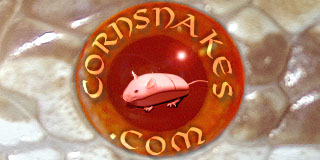DeadMouse
Hungry, hungry Hognose!
It's been a very interesting last couple of days here as I've had a second clutch of Anacondas hatching from an unrelated female to the first clutch we hatched out this summer.
The mother for the first clutch is a supposed 100% het Albino that, for all intents and purposes, is a common variety Western hognose in appearance. When I bred our Anaconda male to her, I pretty much expected typical looking Anacondas which was what I basically got. Yeah, according to the aforementioned thread, I was a little disappointed only because of all of the really wild looking Anacondas that others were producing this year and I was hoping to have at least produced one that was "different". Well, that wish has finally been realized!
This clutch was produced with our Blond female who has a gene for producing stripes. This gene was unknown to exist in her until we bred her for the first time last year (2009) to our male Pink Pastel and produced this outstanding specimen:
Blond x het PPA (2009)

Out of the 6 hatchlings we got from that 2009 pairing, this was the one with the most consistent striping. The other 3 hatchlings that exhibit this striping only have a few here and there and are sometimes hard to determine unless you know what you are looking for. Naturally I was very hesitant to think if this was a heritable trait or not and was just assuming that this could have been a random mutation for this clutch.
This year (2010) we decide to breed our Anaconda to this same Blond female in the hopes that we might see this striping resurface which would prove to us that it is in fact a heritable gene although still undetermined whether it's a complex line trait (polygenic) or a simple Mendelian trait (monogenic). Here was the first hatchling to poke out:
Blond x Anaconda pairing (2010)

Just to reiterate, here's a picture of the Anaconda from the het Albino mother that we hatched out this summer:
het Albino x Anaconda pairing (2010)

If you notice, the one thing that is completely different is the dorsal spotting. While this is fairly prominent in the het Albino offspring, it's quite diminished in the Blond x Anaconda offspring. You can also see on the sides how the striping is apparent almost like the het PPA 2009 specimen. In fact, I've hatched out another Anaconda from this clutch that looks pretty much like the one pictured here, absent of most dorsal patterning. The other 3 Anacondas from this clutch have some striping too but also have heavy spotting on the dorsals as well. So far out of 6 hatched of the 8 eggs hatched, 5 are Anacondas and only one normal.
The mother for the first clutch is a supposed 100% het Albino that, for all intents and purposes, is a common variety Western hognose in appearance. When I bred our Anaconda male to her, I pretty much expected typical looking Anacondas which was what I basically got. Yeah, according to the aforementioned thread, I was a little disappointed only because of all of the really wild looking Anacondas that others were producing this year and I was hoping to have at least produced one that was "different". Well, that wish has finally been realized!
This clutch was produced with our Blond female who has a gene for producing stripes. This gene was unknown to exist in her until we bred her for the first time last year (2009) to our male Pink Pastel and produced this outstanding specimen:
Blond x het PPA (2009)

Out of the 6 hatchlings we got from that 2009 pairing, this was the one with the most consistent striping. The other 3 hatchlings that exhibit this striping only have a few here and there and are sometimes hard to determine unless you know what you are looking for. Naturally I was very hesitant to think if this was a heritable trait or not and was just assuming that this could have been a random mutation for this clutch.
This year (2010) we decide to breed our Anaconda to this same Blond female in the hopes that we might see this striping resurface which would prove to us that it is in fact a heritable gene although still undetermined whether it's a complex line trait (polygenic) or a simple Mendelian trait (monogenic). Here was the first hatchling to poke out:
Blond x Anaconda pairing (2010)

Just to reiterate, here's a picture of the Anaconda from the het Albino mother that we hatched out this summer:
het Albino x Anaconda pairing (2010)

If you notice, the one thing that is completely different is the dorsal spotting. While this is fairly prominent in the het Albino offspring, it's quite diminished in the Blond x Anaconda offspring. You can also see on the sides how the striping is apparent almost like the het PPA 2009 specimen. In fact, I've hatched out another Anaconda from this clutch that looks pretty much like the one pictured here, absent of most dorsal patterning. The other 3 Anacondas from this clutch have some striping too but also have heavy spotting on the dorsals as well. So far out of 6 hatched of the 8 eggs hatched, 5 are Anacondas and only one normal.
